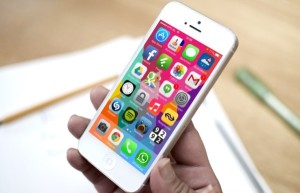 Four months after releasing iOS 7 – the latest major update to the operating system controlling Apple mobile devices – iOS 7.1 has hit the airwaves, providing bug fixes, performance enhancements and a few welcome additions for your iPhone, iPad or iPod Touch.
Four months after releasing iOS 7 – the latest major update to the operating system controlling Apple mobile devices – iOS 7.1 has hit the airwaves, providing bug fixes, performance enhancements and a few welcome additions for your iPhone, iPad or iPod Touch.
iOS 7.1 has been available to developers since November, and the development cycle has seen five separate builds, each version containing minor tweaks to the user interface in addition to the usual bug fixes. The final release can be downloaded and installed from iTunes on a Mac or a PC to a physically connected mobile device (when you plug your phone in, you’ll see a button called Check for Update); you can also download it wirelessly on the device itself by using the Software Update feature located under the General section within the Settings app.
Update sizes vary from slightly over 200MB to 1.4GB, depending on the previous version of OS 7 you are upgrading from. Generally, users upgrading from the latest public release version 7.0.6 should see a smaller update; those with access to the developer beta builds of 7.1 will see much larger file sizes.
Faster and cleaner
There’s nothing too different about 7.1, interface-wise. But the biggest improvement will certainly be one of the most appreciated: performance enhancements. Though iOS 7 and 7.1 benchmark roughly the same, navigating the user interface feels much faster due to speedier animations and decreased loading times caused by waiting for the transitions to finish.
iPhone 4 users should see a noticeable improvement in navigating their device, returning much of the performance that was lost in the move from iOS 6 to iOS 7. Gone are the jittery interface animations seen when opening folders and apps; instead, transitions happen much more smoothly.
Among the many tweaks: The month view in Calendar now has a new icon to the left of the Search field that brings up a list of your events.
Also, iPad users should notice cleaner animation when using the clench gesture to quit out of an app and return to the Home Screen.
There are numerous bug fixes, including one for the Home Screen crash. This bug has been affecting iOS 7 users since shortly after the release in September – some users experienced it several times a day. If you’ve never run into this problem, consider yourself fortunate. At random times, the device would flash and interrupt whatever you were doing, display a solid white/black Apple icon on a solid black/white screen and, after a few moments, return you to the lock screen. This behavior was sporadic, annoying, and with 7.1, it should be gone. Good riddance.
Another fix involves TouchID, the fingerprint scanner found on the iPhone 5S. Some users found that the TouchID scanner decreased in accuracy over time, but with 7.1, it should work more reliably.
There’s a fix for a glitch in the Mail badge – previously it couldn’t display more than 10,000 unread messages – and notifications are now cleared on your other Apple devices when you answer a FaceTime call.
Interface changes
Some minor interface additions and animations have been added. For instance, when you hold the power button at the top of your device, you’ll see an animation for power off. A power button will appear near the top of the screen, and a track with the message “slide to power off” will expand from that button, floating atop a blurred background, making the power-off command and the ability to cancel (located toward the bottom of the screen, just above the home button) a little more obvious. Sliding the onscreen power button to the right now causes the screen to progressively darken.
The power-off animation uses circles instead of the rectangles of iOS 7, and that theme is fairly consistent throughout the interface in 7.1. For instance, the Phone app used to display a large Call rectangle beneath the dialer, but in 7.1, this is now a circle below the 0 button. When making a call using the dialer, pressing the green Call button kicks in an animation in which the phone avatar shifts from its upright position to its side while the button itself fades from green to red, indicating that a press will now hang up the call.
Previously, there were four rectangles that contained the options to Decline, Answer, Remind Me and Message if a call came in while you were using your iPhone. These have been replaced with a circular red Decline button on the lower left and a green Accept button on the lower right, with Remind Me and Message options floating as little icons just above the more prominently displayed Decline/Accept. The layout is the same as before, but the implementation is a little different.
When a call comes in when you’re on another call, instead of the options being displayed as rectangles stacked on the screen, they’re once again replaced with circular icons, located across the bottom of the display tagged: End & Accept, Send to Voicemail and Hold & Accept.
The Phone application isn’t the only app to get tweaks: The month view in Calendar now has a new icon to the left of the Search field that brings up a list of your events. Tapping that same button in the Day view brings up a scrollable list of every event, not just the ones listed for the day.
There’s a slight change on the Lock Screen if you have a TouchID-enabled iPhone: The message Slide to Unlock takes a few seconds to appear compared to devices that do not have TouchID. This was probably implemented because using the fingerprint scanner doesn’t require the slide to unlock gesture.
The Camera app lets you know when auto-flash is enabled by displaying a little lightning icon when the flash will be used, so there are no surprises when you take the picture. Also, iPhone 5S users now have the option to automatically use HDR when the conditions dictate it.
The Notification Center no longer displays a blank area when there are no notifications to display; now it actually shows the text “No Notifications.”
Darken Colors, which darkens some of the fonts – mostly tappable words used for navigating the operating system.
There are a few new options under Accessibility (located under General in the Settings app). There is an option to Increase Contrast which offers three choices: Reduce Transparency, which does away with the frosted glass look in parts of the operating system such as Dock and Notification Center; Darken Colors, which darkens some of the fonts – mostly tappable words used for navigating the operating system; and Reduce White Point, which dims the overall brightness of the display.
Directly below the Increase Contrast option under Accessibility, there is an option to Reduce Motion, which also changes the way multitasking areas pop up (fading in instead of zooming into view) and disables animations in the Weather application.
When choosing wallpapers, you can now disable the parallax effect, which, in concert with Reduce Motion, should help those who are disturbed by the constant zooms and fades.
Finally, there’s another new option in Accessibility called Button Shapes, which gives an obvious visual cue of the tappable areas of the operating system by surrounding these areas with a box, giving it more of the look of a button. This option pretty much brings back a visual cue that was removed in the jump from iOS 6 to 7 in the name of cleaning up clutter.
Additional tweaks
There are a few more tweaks here and there that should make access to certain features a little easier. For instance, TouchID and Passcode have moved up to the main menu in the Settings app.
In the previous version, Siri would sometimes continue to listen even after a command was issued, especially if there was a lot of background noise. You can still start Siri by pressing and holding the Home button, but with 7.1 you can continue to hold the button until after you’ve finished speaking the command. Releasing causes Siri to stop listening and process what was said.
Speaking of Siri, the technology now supports more regional accents for a few languages, including Australian and UK English, Mandarin Chinese, and Japanese.
iBeacon support is improved, too. An app no longer has to be running (or opened in the background) to receive Beacon notifications; messages will still be received in the lock screen even if you recently restarted your phone and didn’t bother to open up the app. Apple has added CarPlay support, which lets you control your iPhone on a built-in display – assuming your car is equipped with it.
Lastly, you can delete cached software updates from Usage under Settings; previously, you would have to restart the iPhone/iPad and then initiate the check update.
None of these changes is earth-shattering, but most are nice details that add up when you’re using your device on a daily basis – and in a day-to-day routine, 7.1 doesn’t use the battery any more or less than 7.0.x. The refinements, bug fixes, the fact that it’s free and overall improvements make 7.1 an easy update to recommend.





